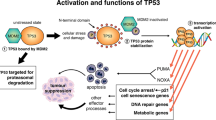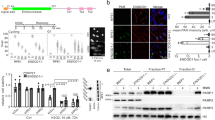Abstract
The p53 protein has a highly evolutionarily conserved role in metazoans as ‘guardian of the genome’, mediating cell-cycle arrest and apoptosis in response to genotoxic injury1. In large, long-lived animals with substantial somatic regenerative capacity, such as vertebrates, p53 is an important tumour suppressor—an attribute thought to stem directly from its induction of death or arrest in mutant cells with damaged or unstable genomes. Chemotherapy and radiation exposure both induce widespread p53-dependent DNA damage. This triggers potentially lethal pathologies2 that are generally deemed an unfortunate but unavoidable consequence of the role p53 has in tumour suppression. Here we show, using a mouse model in which p53 status can be reversibly switched in vivo between functional and inactive states3, that the p53-mediated pathological response to whole-body irradiation, a prototypical genotoxic carcinogen, is irrelevant for suppression of radiation-induced lymphoma. In contrast, delaying the restoration of p53 function until the acute radiation response has subsided abrogates all of the radiation-induced pathology yet preserves much of the protection from lymphoma. Such protection is absolutely dependent on p19ARF—a tumour suppressor induced not by DNA damage, but by oncogenic disruption of the cell cycle.
This is a preview of subscription content, access via your institution
Access options
Subscribe to this journal
Receive 51 print issues and online access
$199.00 per year
only $3.90 per issue
Buy this article
- Purchase on Springer Link
- Instant access to full article PDF
Prices may be subject to local taxes which are calculated during checkout




Similar content being viewed by others
References
Lane, D. P. p53, guardian of the genome. Nature 358, 15–16 (1992)
Gudkov, A. V. & Komarova, E. A. The role of p53 in determining sensitivity to radiotherapy. Nature Rev. Cancer 3, 117–129 (2003)
Christophorou, M. A. et al. Temporal dissection of p53 function in vitro and in vivo. Nature Genet. 37, 718–726 (2005)
Lain, S. & Lane, D. Improving cancer therapy by non-genotoxic activation of p53. Eur. J. Cancer 39, 1053–1060 (2003)
Jacks, T. et al. Tumor spectrum analysis in p53-mutant mice. Curr. Biol. 4, 1–7 (1994)
Donehower, L. A. et al. Mice deficient for p53 are developmentally normal but susceptible to spontaneous tumours. Nature 356, 215–221 (1992)
Kemp, C. J., Wheldon, T. & Balmain, A. p53-deficient mice are extremely susceptible to radiation-induced tumorigenesis. Nature Genet. 8, 66–69 (1994)
Komarova, E. A. & Gudkov, A. V. Could p53 be a target for therapeutic suppression? Semin. Cancer Biol. 8, 389–400 (1998)
Gorgoulis, V. G. et al. Activation of the DNA damage checkpoint and genomic instability in human precancerous lesions. Nature 434, 907–913 (2005)
Bartkova, J. et al. DNA damage response as a candidate anti-cancer barrier in early human tumorigenesis. Nature 434, 864–870 (2005)
Prowse, K. R. & Greider, C. W. Developmental and tissue-specific regulation of mouse telomerase and telomere length. Proc. Natl Acad. Sci. USA 92, 4818–4822 (1995)
Kipling, D. & Cooke, H. J. Hypervariable ultra-long telomeres in mice. Nature 347, 400–402 (1990)
Wu, X. & Levine, A. J. p53 and E2F-1 cooperate to mediate apoptosis. Proc. Natl Acad. Sci. USA 91, 3602–3606 (1994)
Wagner, A. J., Kokontis, J. M. & Hay, N. Myc-mediated apoptosis requires wild-type p53 in a manner independent of cell cycle arrest and the ability of p53 to induce p21waf1/cip1. Genes Dev. 8, 2817–2830 (1994)
Serrano, M., Lin, A. W., McCurrach, M. E., Beach, D. & Lowe, S. W. Oncogenic ras provokes premature cell senescence associated with accumulation of p53 and p16INK4a. Cell 88, 593–602 (1997)
Lowe, S. W., Cepero, E. & Evan, G. Intrinsic tumour suppression. Nature 432, 307–315 (2004)
Hermeking, H. & Eick, D. Mediation of c-Myc-induced apoptosis by p53. Science 265, 2091–2093 (1994)
Zindy, F. et al. Myc signaling via the ARF tumor suppressor regulates p53-dependent apoptosis and immortalization. Genes Dev. 12, 2424–2433 (1998)
Palmero, I., Pantoja, C. & Serrano, M. p19ARF links the tumour suppressor p53 to Ras. Nature 395, 125–126 (1998)
de Stanchina, E. et al. E1A signaling to p53 involves the p19ARF tumor suppressor. Genes Dev. 12, 2434–2442 (1998)
Bates, S. et al. p14ARF links the tumour suppressors RB and p53. Nature 395, 124–125 (1998)
Quelle, D. E., Zindy, F., Ashmun, R. A. & Sherr, C. J. Alternative reading frames of the INK4a tumor suppressor gene encode two unrelated proteins capable of inducing cell cycle arrest. Cell 83, 993–1000 (1995)
Mao, L. et al. A novel p16INK4A transcript. Cancer Res. 55, 2995–2997 (1995)
Kamijo, T. et al. Tumor suppression at the mouse INK4a locus mediated by the alternative reading frame product p19ARF. Cell 91, 649–659 (1997)
Zindy, F. et al. Arf tumor suppressor promoter monitors latent oncogenic signals in vivo. Proc. Natl Acad. Sci. USA 100, 15930–15935 (2003)
Sluss, H. K., Armata, H., Gallant, J. & Jones, S. N. Phosphorylation of serine 18 regulates distinct p53 functions in mice. Mol. Cell. Biol. 24, 976–984 (2004)
Liao, M. J., Yin, C., Barlow, C., Wynshaw-Boris, A. & van Dyke, T. Atm is dispensable for p53 apoptosis and tumor suppression triggered by cell cycle dysfunction. Mol. Cell. Biol. 19, 3095–3102 (1999)
Harms, K., Nozell, S. & Chen, X. The common and distinct target genes of the p53 family transcription factors. Cell. Mol. Life Sci. 61, 822–842 (2004)
Soengas, M. S. & Lowe, S. W. p53 and p73: seeing double? Nature Genet. 26, 391–392 (2000)
Acknowledgements
We thank F. Rostker and the Genome and Pathology Cores at UCSF for technical assistance, J. Hwang for statistical analysis, J. H. Mao, F. McCormick, C. O'Shea, K. Shannon and the entire Evan laboratory for critical discussions. We thank T. Littlewood and D. Martin Zanca for showing that the p53ERTAM knockin mouse was feasible. This work was supported by grants from the National Cancer Institute and National Institute on Aging.
Author information
Authors and Affiliations
Corresponding author
Ethics declarations
Competing interests
Reprints and permissions information is available at www.nature.com/reprints. The authors declare no competing financial interests.
Supplementary information
Supplementary Notes
This file contains a detailed description of the Supplementary Methods. (PDF 76 kb)
Supplementary Figure Legends
This file contains text to accompany the below Supplementary Figures. (PDF 77 kb)
Supplementary Figure 1
Global DNA damage is rapidly resolved in p53KI/KI tissues after a single acute dose of y-irradiation (PDF 6483 kb)
Supplementary Figure 2
The p53-dependent response to acute DNA damage decays rapidly in p53+/+ tissues after a single acute dose of y-irradiation (PDF 7138 kb)
Supplementary Figure 3
p53 restoration in p53KI/KI animals delays the development of spontaneous lymphoma (PDF 35 kb)
Supplementary Figure 4
p19ARF protein is expressed in lymphoid tumors arising in p53KI/KI mice never exposed to 4-OHT (PDF 149 kb)
Supplementary Figure 5
Schematic representation of the proposed roles of p53 in acute DNA damage responses and tumor suppression (PDF 38 kb)
Rights and permissions
About this article
Cite this article
Christophorou, M., Ringshausen, I., Finch, A. et al. The pathological response to DNA damage does not contribute to p53-mediated tumour suppression. Nature 443, 214–217 (2006). https://doi.org/10.1038/nature05077
Received:
Accepted:
Published:
Issue Date:
DOI: https://doi.org/10.1038/nature05077
This article is cited by
-
Decoding p53 tumor suppression: a crosstalk between genomic stability and epigenetic control?
Cell Death & Differentiation (2024)
-
Characterizing the role of Phlda3 in the development of acute toxicity and malignant transformation of hematopoietic cells induced by total-body irradiation in mice
Scientific Reports (2023)
-
Long-term p21 and p53 dynamics regulate the frequency of mitosis events and cell cycle arrest following radiation damage
Cell Death & Differentiation (2023)
-
Exploring the multiple roles of guardian of the genome: P53
Egyptian Journal of Medical Human Genetics (2020)
-
Emerging mechanisms of cell competition
Nature Reviews Genetics (2020)
Comments
By submitting a comment you agree to abide by our Terms and Community Guidelines. If you find something abusive or that does not comply with our terms or guidelines please flag it as inappropriate.



